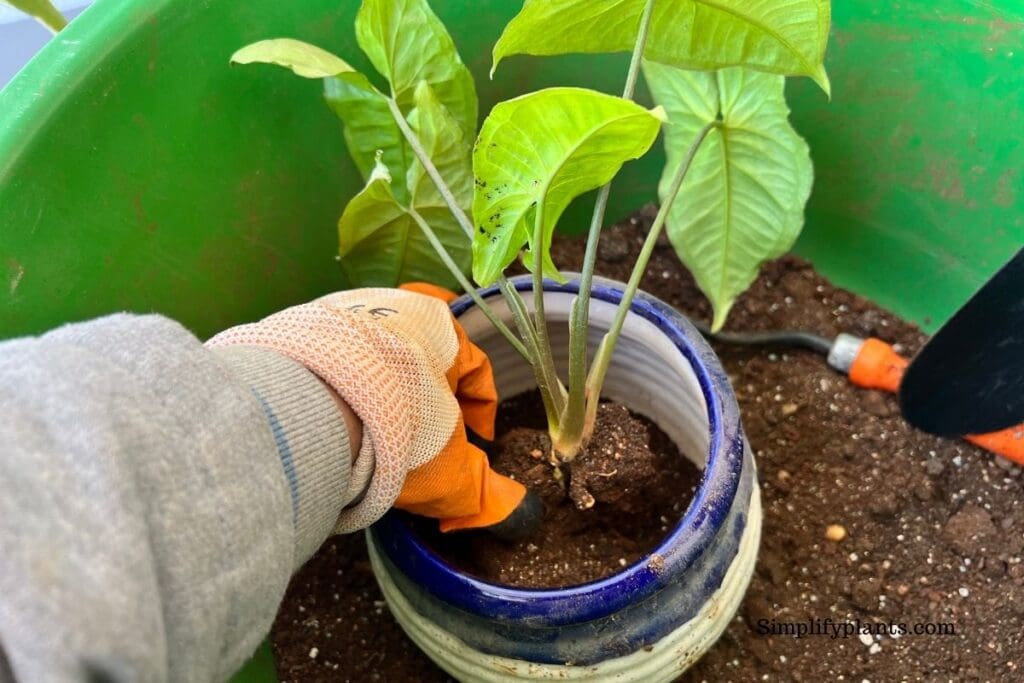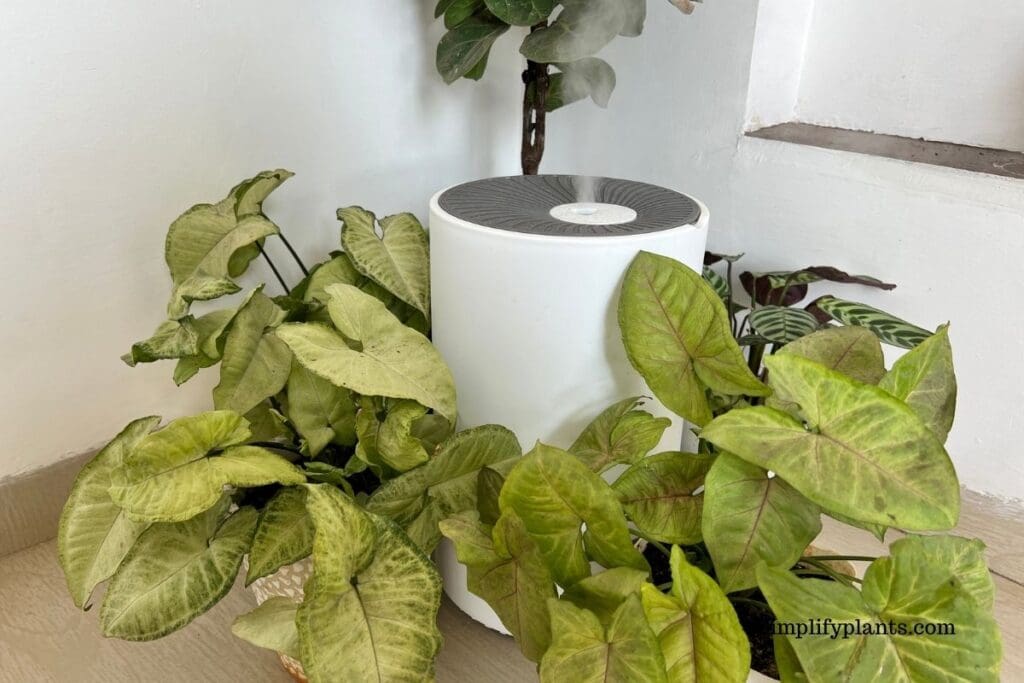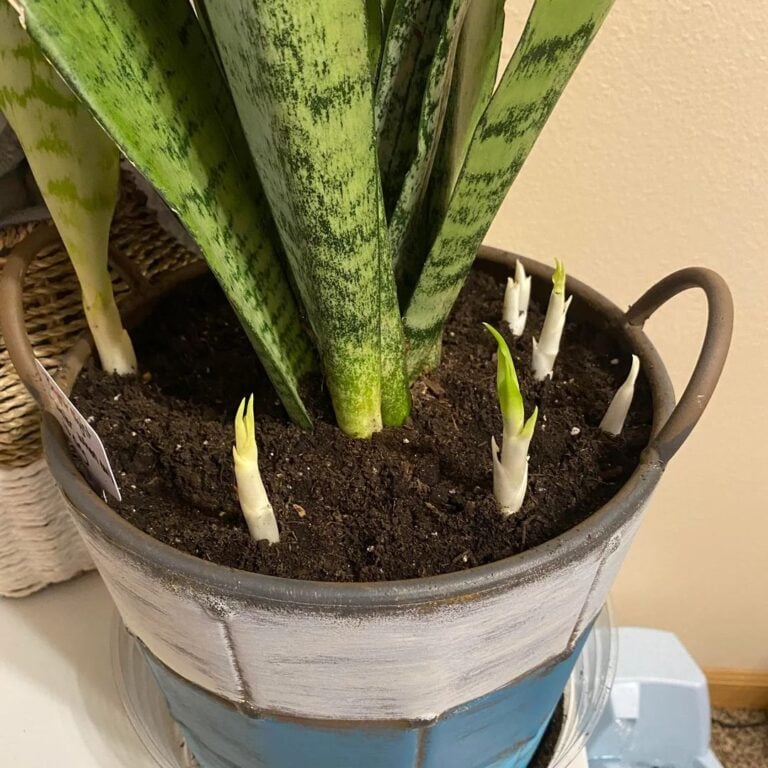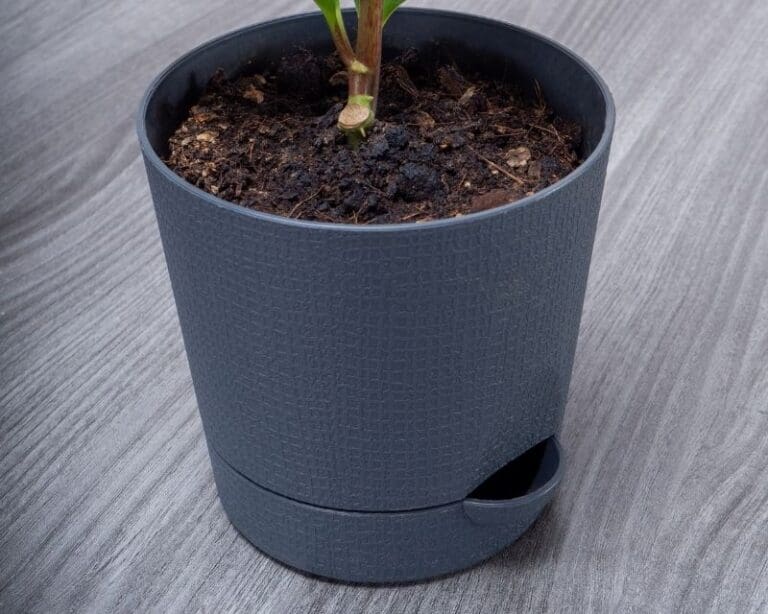When To Repot Arrowhead Plant? (Best Time+How To)
Repotting houseplants is probably a task many plant owners are guilty of ignoring. However, repotting is extremely crucial otherwise, the plant may suffocate and stop growing and eventually die.
Arrowhead plants have an extensive root structure. When the roots grow too extensive in indoor gardening, the pots can even break in need of space.
The ideal time to repot an arrowhead plant is during spring and early summer. Always repot the plant if it shows signs like overgrown roots, soil displacement, and stunted growth. An arrowhead plant will require repotting once every 2-5 years to replenish the lost nutrients.
This article will cover everything you must know about repotting an arrowhead plant. So, let’s get started.

Please note: Simplify Plants is reader-supported. Some links in the post are affiliate links and I get a commission from purchases made through links in the post.
When to repot an arrowhead plant?
Repotting is required when your arrowhead plant grows too big for its current pot.
Repotting at the right time encourages healthy growth and allows the plant to absorb necessary nutrients, air, and food from the soil.
Therefore, when we repot our houseplant in fresh soil, it gets more energy.
Arrowhead plants require repotting every 2-5 years as they have a huge root system, so they need more space to spread and grow over time.
The best time for repotting is spring to early summer.
You should avoid repotting during winters because it is not their growing season.
Since repotting is a huge change for the plants, it stresses the plant, so we must be careful.
You should not repot your Syngonium unless it shows signs that indicate it needs repotting.
The plant can get root bound, which signifies that it needs repotting.
Some of the symptoms are drooping leaves, roots coming out of the drainage hole, the plant getting dehydrated frequently, etc.
Importance of repotting an arrowhead plant

Repotting helps the plant grow with added energy and nutrients.
The extensive root structure of your arrowhead plant gets more space to grow once it gets repotted with fresh soil and pot.
Let us discuss how repotting helps your arrowhead plant.
Replenishes your arrowhead plant with nutrients and rich soil
While the Syngonium grows in the soil for some years, the nutritional value of the soil keeps depleting.
It loses its nutrients with every watering as they get washed away.
The soil also starts becoming acidic with time.
When we repot the Syngonium in fresh soil with fresh organic elements, it boosts the growth of the arrowhead plant.
Improves water flow in the roots
Sometimes while watering our arrowhead plant, we notice that the water starts to seep out of the drainage holes as soon as we water.
It is a sign of a root-bound plant and that the roots are not getting the necessary water.
The toots of the root-bound plant become so tangled that the water immediately drains out without getting a chance to seep inside the roots.
But when we repot our arrowhead plants, we provide them space by loosening them up for better absorption of the nutrients and water from the soil.
Prevent diseases of the roots
Sometimes, the roots get infected by pests due to getting overwatered and staying in excess moisture for too long.
While repotting the plant, the infected and dead roots are trimmed away.
This helps the healthy roots grow faster and prevents infections and pest attacks.
It is essential to trim the damaged and dead roots and leaves while repotting the plant in a fresh soil mix and pot.
More space and aeration for the roots
Arrowhead plants have an expansive root system.
Thus, eventually, the roots need space to spread and grow.
As they keep growing, the space falls short, and the roots get cramped, suffocating each other and making the plant weak.
Repotting the plant to a bigger pot gives the necessary space, helping the robust arrowhead roots grow rapidly.
Propagation
Repotting helps in propagation if you want to multiply your Syngonium.
While repotting, when you prune the stems, separate them carefully and propagate them in separate pots.
This would help you get more arrowheads without having to buy new ones.
Also read: How To Propagate Arrowhead Plant? (2 Ways+A Step-by-Step Guide)
Signs your arrowhead plant needs repotting

So how do you understand if your arrowhead plant requires repotting?
There are some signs that the plant shows to let you know that the plant needs repotting.
Rootbound arrowhead plant
There are several signs of a root-bound plant.
The leaves start to get yellow, wilted and the soil tends to dry quickly between watering.
If you doubt your plant is getting root bound, check the roots.
If you see roots coming out of the drainage holes or moving in a circular motion, it signifies that your arrowhead plant is root-bound.
When you face this situation, you must repot your Syngonium immediately to a bigger pot with fresh soil.
Also read: Do Arrowhead Plants Like To Be Root Bound? (+Signs & When To Repot)
Compact soil
If you don’t repot for too long, the soil gets compact, not letting the water or nutrients get absorbed by the roots.
So, in this case, when we water them, the water directly flows out of the drainage holes instead of reaching the roots.
Old soil tends to get compact which becomes a barrier for water, nutrition, and air to reach the plant roots.
Overgrown roots
Arrowhead plants have a strong, expansive root system.
When the Syngonium grows too big for its existing pot, the roots get restricted.
The roots would start coming out from the drainage holes at the bottom of the pot, or the roots start becoming visible on the soil surface.
The roots block the drainage holes, which stops the water from passing out of the holes, leading to the roots staying soaked in water for too long.
Bizarre growth
When your arrowhead plant doesn’t get the repotting it needs, it starts growing abnormally.
You’ll notice that the plant grows upwards but not in width.
This is also a sign that your Syngonium is root-bound.
Due to a lack of nutrients and water, the plant also grows slowly.
Also read: Why Is My Arrowhead Plant Not Growing? (Causes+How To Fix)
Salt accumulation
As you keep fertilizing your arrowhead plant, it keeps accumulating in the soil and creates a layer.
This layer absorbs the necessary water and food, not reaching the plant.
One method plant growers follow to wash off these unnecessary salts is flushing the soil.
You can water your Syngonium twice or thrice until it comes out of the drainage holes, after which you can pour a water-vinegar solution to neutralize the salts and lower the pH.
However, we tend to forget about flushing the soil with passing time, and the salt layer thickens and becomes more compact.
Repotting here is the only way out to save the Syngonium.
How often to repot the arrowhead plant?

Houseplants require repotting every few years, depending on the growth and type.
It is not the same for every plant, and you have to understand your plant’s needs whether it requires repotting following the signs of the plant.
Slow-growing plants can do without repotting for years.
However, plants like Syngonium require repotting every 2-5 years.
Because of the widespread root system of arrowheads, they need a bigger pot with fresh soil and nutrients.
New soil gives them the necessary food and helps them grow rapidly with new leaves.
More than giving a fixed timeline to repot your arrowhead, you must look for the signs and symptoms of the plant to understand whether it requires repotting.
Best time to repot your arrowhead plant
You should repot your arrowhead plant in the active seasons so that it can overcome the stress of repotting.
You must avoid repotting your Syngonium during winter because it stays the least active during this time, so it might not be able to overcome the shock.
Spring and summer are ideal for repotting for most houseplants, and arrowhead vines are no different.
During this season, arrowhead plants grow the most, and hence they are the strongest to overcome the repotting shock easier than other seasons.
Arrowhead plants do not like to be disturbed during the cold months, so you must wait for warmer months unless it’s urgent.
So, the best time to repot the arrowhead plant is during spring and early summer.
The beginning of March is the ideal time to repot your arrowhead.
Also read: Do Arrowhead Plants Go Dormant? (Winter Dormancy+Care)
Correct pot size for the arrowhead plant

Arrowhead plant likes to stay in a compact pot.
It helps the plant grow the most, but it can suffocate the roots if the pot size is too small.
The pot should be proportionate to the size of the plant.
If the plant is small, you can plant it in a 6” pot, and once you see it getting root bound and growing too big for the pot, you can transfer it to an 8” pot.
Do not repot your plant in a pot more than 1-2 inches bigger than your existing pot size.
A too-big pot for your arrowhead plant can absorb more water, leading to overwatering and root rot.
Another factor to remember while choosing the perfect pot for your Syngonium is that the pot must contain adequate drainage holes.
The drainage holes help the excess water of the pot to drain out of the pot.
It prevents root rot and the accumulation of water at the bottom.
Sometimes we want to have fancy planters for our plants, but if they do not have drainage holes, we can use normal clay pots to plant the arrowhead and insert that plant along with the clay pot in the fancy pot.
This way, the excess water would not disturb the plant and get accumulated in the fancy pot, which we can just manually empty away.
One more factor is the material of the pot.
Clay pots are the best as they are porous, and the roots can breathe through them instead of plastic or ceramic pots.
If you want to use ceramic pots, you can plant the arrowhead in clay pots and then keep the plant inside the fancy ceramic pots.
Some people like to use decorative pots with a narrow mouth, but these can get problematic when you take out the plant to repot it.
Correct potting mix for your arrowhead plant

While repotting the arrowhead plant, make sure the soil is rich and fertile.
In nature, these plants grow under big trees where the soil is extremely fertile due to organic matters falling into them, so they like rich soil which is light and well-draining.
The soil should not be too tight.
It should be loose and airy so that the roots get air and nutrients, and space to extend.
The perfect mix for the arrowhead plant would be 50% potting soil, 30% parts of coco coir, and 20% pumice.
You can add some compost to the soil as well.
For compost, you can use cow manure, bone meal, etc. they are rich in nutrients and help the plant get the necessary nutrition.
Also read: What Kind Of Soil For Arrowhead Plant? (+Best Soil Mix)
Repotting the arrowhead plant
Now to repot the plant, you should follow some steps.
I have made a list of things you need while repotting the arrowhead.
- The plant
- A new pot
- Fresh soil mix
- Rocks to cover the drainage holes
- Water
Let us discuss the steps to repot the Syngonium.
- Water the arrowhead a day before repotting. This will moisten the soil and allow the plant to easily come out of its pot.
- Choose the new pot for the arrowhead before starting with the repotting process. Keep the factors discussed above in mind to select the appropriate pot.
- Prepare the soil mix with potting soil, coco coir, pumice, or perlite.
- Fill the pot with small rocks so that the soil does not drain out with the water when you water your arrowhead.
- Hold the arrowhead plant and gently turn the pot upside down and pull out the arrowhead plant from the pot. If the plant is root-bound and does not come out, tap the bottom of the pot with your hand or elbow and pull out the plant. Use a knife to loosen the soil, and do not forget to sterilize it.
- Once the Syngonium is out of its pot, separate the roots gently and massage them. Loosen up the root ball, so they spread easily in the new pot, and also this gives the roots more chances to breathe and loosen up. If you see any dead roots or infected roots, just trim them away. Cut off the dead or yellow leaves.
- Take the new pot and fill the pot with the soil mix and carefully place the arrowhead plant in the new pot at the center and then start adding the potting mix. Fill the pot with soil mix on all sides and press the soil softly with your hand to cover the gaps in the soil.
- Once done, water the arrowhead generously until you see the water coming out of the drainage holes.
- After this, move the plant to a bright location with plenty of light and air. But keep it out of the reach of the direct sun.
Post repotting care

After the repotting is done, it is important to watch your arrowhead plant.
The plant can undergo heavy stress after repotting, making the leaves wilt and turn droopy or fall off.
The arrowhead might seem droopy for some days because repotting gives immense stress to the plant.
However, the plant should start showing signs of recovery within 3-4 days once they adjust to the new soil.
During this time, do not disturb the plant.
Water when the soil gets dry and keep them in a well-lit place.
Final words
Look for the signs if your arrowhead needs repotting. They are easy to grow and hardy. But without repotting, they can get stressed and develop different issues.
Therefore, you must repot your arrowhead at least once in 2-5 years. Repot it during spring and early summer and avoid repotting in winter unless there is an urgent condition like root rot.
After repotting:
- Keep a check on your arrowhead.
- Give it the necessary nutrients and environment.
- Watch it flourish and grow.
Reference: CABI, Britannica, United States Department of Agriculture, Wikipedia, Children’s Health Queensland Hospital and Health Service, Missouri Botanical Garden.
Recommended Garden Supplies
| Product Image | Our Recommended Gardening Supplies | Check Offers! |
|---|---|---|
Top Top
Top
Top
Top
Top
Top
Top
Top | rePotme Houseplant and Tropical Classic Potting Soil Mix | Check Offer On Amazon |
 Top
Top
Top
Top
Top
Top
Top
Top | Espoma Organic Indoor Plant Food | Check Offer On Amazon |
 Top
Top
Top
Top
Top
Top
Top
Top | GooingTop LED Grow Light 6000K Full Spectrum Clip Plant Growing Lamp | Check Offer On Amazon |
 Top
Top
Top
Top
Top
Top
Top
Top | Soil Moisture Meter | Check Offer On Amazon |
 Top
Top
Top
Top
Top
Top
Top
Top | Govee Hygrometer Thermometer, Bluetooth Enabled! | Check Offer On Amazon |
 Top
Top | LEVOIT Humidifiers for Large Room(Best For Plants) | Check Offer On Amazon |
 Top
Top
Top
Top
Top
Top
Top
Top | Upgraded DIY Automatic Drip Irrigation Kit, 15 Potted Houseplants Support | Check Offer On Amazon |
 Top
Top
Top
Top
Top
Top
Top
Top | Stainless Steel Heavy Duty Gardening Tool Set | Check Offer On Amazon |
 Top
Top
Top
Top
Top
Top
Top
Top | Bonide Insecticidal Soap | Check Offer On Amazon |
 Top
Top
Top
Top
Top
Top
Top
Top | Bonide 32 oz Spray Neem Oil for Organic Gardening | Check Offer On Amazon |
 Top
Top
Top
Top
Top
Top
Top
Top | Garden Safe Fungicide | Check Offer On Amazon |






